Palestinian artist Hazem Harb doesn’t try to define the idea of Palestine in his work. “For me, Palestine just is,” he tells me. “I’m interested in its history and nationalism, but I don’t dwell on them by making straightforward political art. In my work, I’m trying to represent the hidden narratives of Palestine and leave room for individual memories and personal stories to come through.”
Moving from his native Gaza to Rome, and now based in Dubai, Harb has had the chance to reflect on the idea of his homeland from different angles, until he decided to make it the centre of his artistic practice. From his Dubai studio, he tells me about the preparation of his latest show in Sharjah that will take place at the end of October. He describes the preparations in a mix of English and Italian, a legacy from his many years spent in Rome. Around him is a mock-up of the museum where his first institutional show will take place, models of his installations that will be realised in full size, some prints, and drawers overflowing with books and images. This is not surprising considering the artist mainly works with archival images.
“When I first started including archival material in my work I simply looked for old pictures of Palestine on the internet. Over the years, I felt the need to delve much deeper.”
The unseen and the un-thought: Hunna/ هُنَّ gallery represents powerful women artists from the Gulf
Today some of his photographs, maps and archival materials have been gifted to him by Palestinian families in the Diaspora. Others he has found in specific books, sometimes very rare and old. “As my career as an artist progressed I was able to afford iconographic materials from auctions.” With great care, he pulls out an 1885 book about flowers in Palestine called “Flowers of the Holy Land”. Inside are actual dried flowers, preserved in time.
“It’s like time travel,” I observe.
“It really is,” he agrees.
Time travel is indeed the feeling we get when facing the collages, installations and images produced by the artist. His collector’s ethos guides him in a quest for eternity of sorts. However, not all the materials he acquires are turned into artworks straight away. Some wait for years before it happens. Sometimes they never make it, but they always end up informing Harb’s art in a subtle way.
He mentions that a lot of ideas for his art come from books — he is currently re-reading Edward Said’s Orientalism — but for him a necessary step is to visualise an artwork before actually realising it. He opens a big notebook where he treasures a number of installation sketches, architectural drawings, rough ideas of things in which one can recognise the seeds of some of his most iconic works. Drawing is for him an alternative way of thinking:
“I have always painted since I was a child,” he says. “But strangely enough, I’d say my first memory tied to art is asking my mother to show me a stack of old photographs in a box.”
Born in 1980, Hazem Harb grew up during the First Intifada in Gaza as one of eight children in his family. He remembers himself sketching and drawing portraits constantly. “Since I was a kid I have always been very curious and interested in things. Maybe too interested at times; sometimes it’s overwhelming. I actually have a work that is called ‘Too Much Information in my mind’, and I guess the title says it all.”
In Gaza, he first studied drawing at the YMCA, which at the time held excellent workshops, but his dream was always to travel to Italy. “I had posters of Italy in my room, so as soon as I had the chance to study at the Art Academy in Rome through a scholarship, I was over the moon.”
He focused his early practice on figurative painting. It all changed when he encountered another Italian figurative artist, Riccardo Mannelli, who pushed him to further his studies from the classic-based art academy to the more contemporary IED (Instituto Europeo Design), where he started evolving his practice and looking at his roots.
Today Harb’s work is striking in a way that is at once peculiar and universal. Palestine became to him a relatable metaphor for the dynamics of power and the workings of memory. One example is a work called “Military Zones”, where a yellow sign covers vintage photos of a bucolic Palestinian landscape. The space the sign is occupying within the frame is a powerful metaphor for the physical occupation of Palestinian soil, and beyond. The work speaks universally about borders, restriction, bureaucracy and the mobility of people.
His new work for the upcoming show in Sharjah is an emotionally striking way of de-colonising the Palestinian imagination, as well as a sharp look at how architecture contributed to imperialism. The impact of architecture has indeed been very much explored by the artist in past shows like “Bauhaus as Imperialism” and “Archaeology of Occupation”, where he presented striking installations consisting of a cushion squashed between concrete walls, a powerful symbol that can be read politically as well as psychologically.
“I do believe in the responsibility of the artist to contribute in deconstructing the misrepresentation of the east by the west,” he concludes. “But most of all I want to convey alternative stories about Palestine, and connect them to different contexts where similar struggles are happening. That’s the way I will always keep doing art.”

![Palestinian artist Hazem Harb [Hazem Harb]](https://i0.wp.com/www.middleeastmonitor.com/wp-content/uploads/2021/10/hazem.jpg?fit=920%2C614&ssl=1)













